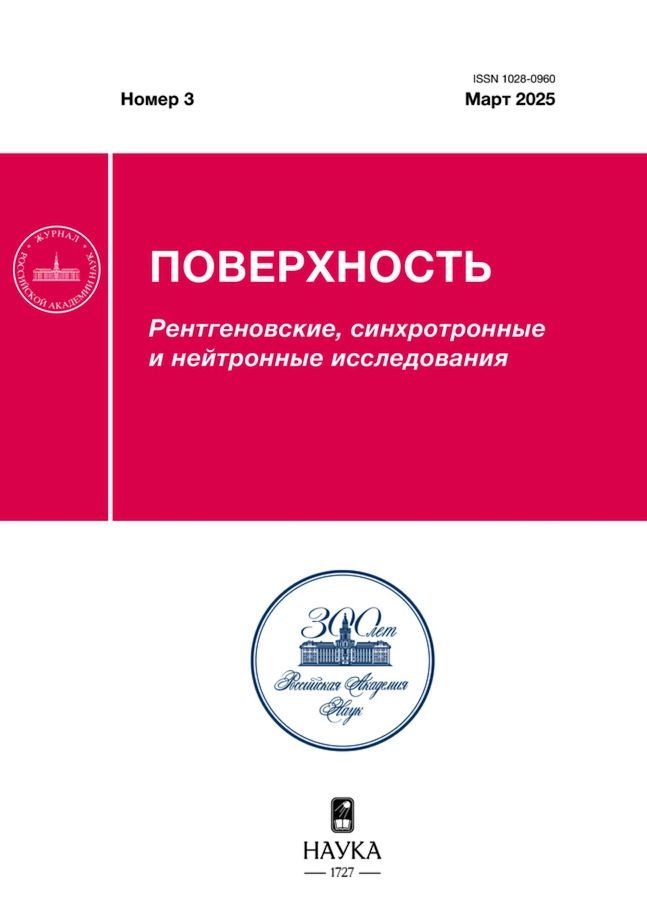Study of xenon ion-induced silicon amorphization using transmission electron microscopy and Monte Carlo simulation
- 作者: Podorozhniy O.V.1, Rumyantsev A.V.1, Borgardt N.I.1, Minnebaev D.K.2, Ieshkin A.E.2
-
隶属关系:
- National Research University of Electronic Technology
- Lomonosov Moscow State University
- 期: 编号 3 (2025)
- 页面: 45-50
- 栏目: Articles
- URL: https://j-morphology.com/1028-0960/article/view/687670
- DOI: https://doi.org/10.31857/S1028096025030074
- EDN: https://elibrary.ru/ELTCQI
- ID: 687670
如何引用文章
详细
Xenon ions with energies of 5 and 8 keV were used to amorphize a single-crystal silicon substrate. Cross-sectional samples of the irradiated areas were examined by transmission electron microscopy in the bright field mode, and the thicknesses of the amorphized layers were determined based on the analysis of the obtained images. Simulation of the ion bombardment process was carried out using the Monte Carlo technique along with critical point defect density model, which made it possible to obtain theoretical estimates of the thickness of these layers. The calculation results were compared with experimental data. Monte Carlo simulation was shown to describe low-energy xenon ion-induced amorphization of single-crystal silicon with acceptable precision.
全文:
作者简介
O. Podorozhniy
National Research University of Electronic Technology
编辑信件的主要联系方式.
Email: lemi@miee.ru
俄罗斯联邦, Zelenograd, Moscow
A. Rumyantsev
National Research University of Electronic Technology
Email: lemi@miee.ru
俄罗斯联邦, Zelenograd, Moscow
N. Borgardt
National Research University of Electronic Technology
Email: lemi@miee.ru
俄罗斯联邦, Zelenograd, Moscow
D. Minnebaev
Lomonosov Moscow State University
Email: lemi@miee.ru
俄罗斯联邦, Moscow
A. Ieshkin
Lomonosov Moscow State University
Email: lemi@miee.ruро
俄罗斯联邦, Moscow
参考
- Ghosh B., Ray S.C., Pattanaik S., Sarma S., Mishra D.K., Pontsho M., Pong W. F. // J. Phys. D. 2018. V. 51. № 9. P. 095304. https://doi.org/10.1088/1361-6463/aaa832
- Vasquez L., Redondo-Cubero A., Lorenz K., Palomares F.J., Cuerno R. // J. Phys.: Condens. Matter. 2022. V. 34. № 33. P. 333002. https://doi.org/10.1088/1361-648X/ac75a1
- Hlawacek G., Veligura V., van Gastel R., Poelsema B. // J. Vac. Sci. Technol. B. 2014. V. 32. № 2. P. 020801. https://doi.org/10.1116/1.4863676
- Petrov Y.V., Vyvenko O.F. // Beilstein J. Nanotechnol. 2015. V. 6. № 1. P. 1125. https://doi.org/10.3762/bjnano.6.114
- Cherepin V.T. Secondary Ion Mass Spectroscopy of Solid Surfaces. CRC Press, 2020. 138 p. https://doi.org/10.1201/9780429070327
- Sawyer W.D., Weber J., Nabert G., Schmälzlin J., Habermeier H.-U. // J. Appl. Phys. 1990. V. 68. P. 6179. https://doi.org/10.1063/1.346908
- Fleisher E.L., Norton M.G. // Heterog. Chem. Rev. 1996. V. 3. № 3. P. 171. https://doi.org/10.1002/(SICI)1234-985X(199609) 3:33.0.CO;2-D
- Smith N.S., Notte J.A., Steele A.V. // MRS Bull. 2014. V. 39. № 4. P. 329. https://doi.org/10.1557/mrs.2014.53
- Höflich K., Hobler G., Allen F.I. et al. // Appl. Phys. Rev. 2023. V. 10. № 4. https://doi.org/10.1063/5.0162597
- Donovan E.P., Hubler G.K., Waddell C.N. // Nucl. Instrum. Methods Phys. Res. B. 1987. V. 19–20. P. 590. https://doi.org/10.1016/S0168-583X(87)80118-0
- Mikhailenko M.S., Pestov A.E., Chkhalo N.I., Zorina M.V., Chernyshev A.K., Salashchenko N.N., Kuznetsov I.I. // Appl. Opt. 2022. V. 61. № 10. P. 2825. https://doi.org/10.1364/AO.455096
- Van Leer B., Genc A., Passey R. // Microsc. Microanal. 2017. V. 23. № 1. P. 296. https://doi.org/10.1017/S1431927617002161
- Kelley R., Song K., Van Leer B., Wall D., Kwakman L. // Microsc. Microanal. 2013. V. 19. № 2. P. 862. https://doi.org/10.1017/S1431927613006302
- Rumyantsev A.V., Borgardt N.I., Prikhodko A.S., Chaplygin Yu.A. // Appl. Surf. Sci. 2021. V. 540. P. 148278. https://doi.org/10.1016/j.apsusc.2020.148278
- Wittmaack K., Oppolzer H. // Nucl. Instrum. Methods Phys. Res. B. 2011. V. 269. № 3. P. 380. https://doi.org/10.1016/j.nimb.2010.11.025
- Румянцев А.В., Приходько А.С., Боргардт Н.И. // Поверхность. Рентген., синхротр. и нейтрон. исслед. 2020. № 9. P. 103. https://doi.org/10.31857/S1028096020090174
- Huang J., Löffler M., Moeller W., Zschech E. // Microelectron. Reliab. 2016. V. 64. P. 390. https://doi.org/10.1016/j.microrel.2016.07.087
- Румянцев А.В., Боргардт Н.И., Волков Р.Л. // Поверхность. Рентген. синхротр. и нейтрон. исслед. 2018. № 6. С. 102. https://doi.org/10.7868/S0207352818060197
- Li Y.G., Yang Y., Short M.P., Ding Z.J., Zeng Z., Li J. // Sci. Rep. 2015. V. 5. № 1. P. 18130. https://doi.org/10.1038/srep18130
- Cerva H., Hobler G. // J. Electrochem. Soc. 1992. V. 139. № 12. P. 3631. https://doi.org/10.1149/1.2069134
- Huang J., Loeffler M., Muehle U., Moeller W., Mulders J.J.L., Kwakman L.F.Tz., Van Dorp W.F., Zschech E. // Ultramicroscopy. 2018. V. 184. P. 52. https://doi.org/10.1016/j.ultramic.2017.10.011
- Mayer J., Giannuzzi L.A., Kamino T., Michael J. // MRS Bull. 2007. V. 32. № 5. P. 400. https://doi.org/10.1557/mrs2007.63
- Eckstein W. Computer Simulation of Ion-Solid Interactions: Berlin–Heidelberg: Springer, 1991. 296 p. https://doi.org/10.1007/978-3-642-73513-4
- Mutzke A., Bandelow G., Schmid K. News in SDTrimSP Version 5.05, 2015. 46 p.
- Wilson W.D., Haggmark L.G., Biersack J.P. // Phys. Rev. B. 1977. V. 15. № 5. P. 2458. https://doi.org/10.1103/PhysRevB.15.2458
- Oen O.S., Robinson M.T. // Nucl. Instrum. Methods. 1976. V. 132. P. 647. https://doi.org/10.1016/0029-554X(76)90806-5
- Lindhard J., Scharff M. // Phys. Rev. 1961. V. 124. № 1. P. 128. https://doi.org/10.1103/PhysRev.124.128
- Süle P., Heinig K.-H. // J. Chem. Phys. 2009. V. 131. P. 204704. https://doi.org/10.1063/1.3264887
- Mutzke A., Eckstein W. // Nucl. Instrum. Methods Phys. Res. B. 2008. V. 266. № 6. P. 872. https://doi.org/10.1016/j.nimb.2008.01.053
- Wittmaack K. // Phys. Rev. B. 2003. V. 68. № 23. P. 235211. https://doi.org/10.1103/PhysRevB.68.235211
补充文件










